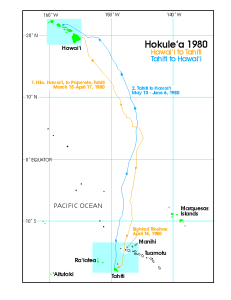
(Geo)graphic brought to you by the Polynesian Voyaging Society.
Late last year, I was waiting in a orthodontist’s office waiting room, and ran across one of the coolest articles I have read in a while. It was an article byWade Davis on Polynesian wayfinding in the magazine National Geographic Adventure. Rather than steal the National Geographic Adventure (which in retrospect I should have done), I figured I would find it online. I assumed that my initial failure to find the article online was due to user error. Week after week, in my abundant spare time, I Googled various combinations of search terms, and came up short. Finally, finding myself back in the waiting room, I rummaged for the magazine, and it was gone.
As it turns out, I was flummoxed because that was NationalGeographic Adventure’s last edition, and the content was never put on the web. Read here for a sad explanation of the course of events (and for a pretty cool blog). But, in the course of searching for the article, I learned even more about open ocean Polynesian migration routes, the Polynesian canoe replicas Hokule‘a and Hawai‘iloa, and the art of wayfinding. I’ve spent so much time working in the worlds of GPS, telematics, and digital navigation technologies that the notion of finding one’s way across hundreds of miles of open ocean in a canoe with nothing more than ancient wayfinding techniques is insane. The folks that populated Polynesia were hardcore.
The “star compass” is their basic mental construct for navigation. The wayfinder memorizes the “houses of the stars”, which are where the constellations come out of the ocean and recede into the ocean. The star compass requires knowledge of different kinds of birds, their flight paths, and the distances that they are capable of ranging from land. It involves reading the luminescent plankton and other sea life and knowing what that means in terms of your proximity to a current or a landmass. And, then there is knowledge of currents’ locations and where they go, as they will quickly take you to predictable places. It goes on and on. And, all this without a clock or speedometer from which one might gauge speed.
Anyways, the Davis’ piece communicates this in an amazing way. Sorry, but I have not gotten to a library to scan in the article and post it. Since NatGeo failed to put their last issue on the web, does that make it Fair Use? Until then, you will just have to live with the less inspirationally written version from the PolynesianVoyaging Society of a different voyage.